
Should Brands Have Opinions? When and How to Get Political…Or Not.
By Mary McCool
From the brands we love to the TV shows we watch to the food we eat, Americans’ political leanings are seen in their choice of products to a new extreme. As brands fight for recognition and engagement in the crowded, competitive atmosphere of social media, engaging with current events can seem like the exact thing to avoid. It might also be the thing that sets your brand apart. But how can brands navigate this choice successfully?
Most Americans get their news from social media. It’s well known that social media creates an echo chamber — a place where, as the Washington Post notes, users “tend to promote their favorite narratives, form polarized groups and resist information that doesn’t conform to their beliefs.”
The president’s Twitter habit of putting highly polarizing political content and “facts” directly in front of the world on a regular basis makes politics seem inescapable, especially on mainstay platforms like Facebook and Twitter.
In a larger context, some characterize the U.S.’s ideological divide as a descent away from democratic institutions and discourse, toward a form of tribalism. In an op-ed, former Secretary of Labor Robert Reich describes this move as a response against the ever-present accessibility of information, seeking the comforts of the familiar by associating with like-minded people:
While this may be the extreme, the fact remains that audiences and the algorithms that serve them are highly selective about the types of content with which they engage and promote, based on preferred ideological lines. Even if one doesn’t use social media as a means to greater civic engagement, the cacophony of voices and the divides they represent are hard to ignore.
In these volatile times, how can a brand balance authenticity and relevance without getting into political hot water? The answer lies in knowing your brand’s core story, and understanding how that plays out in your voice on social media. Here’s a look at some recent successes and failures.
A Legitimate Authority
Merriam-Webster, trusted maker of American English dictionaries, has made an elegant sally into current events, with a crisp, smart voice that stays true to its brand identity. By tartly fact-checking Kellyanne Conway’s “alternative facts” with the simple definition of the word, the brand confirmed its status as an expert.
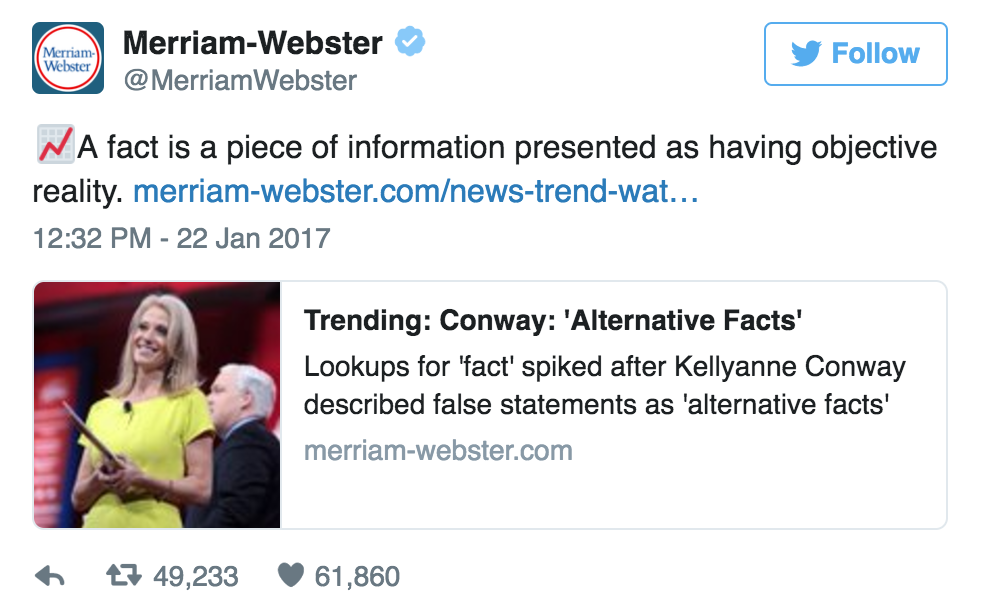
After repeated outcries over Trump’s paid audience applauding multiple speeches, the brand asserted its identity and threw some shade by letting the world know there’s a word for that: a claque. This prompted a response that most brands would envy:
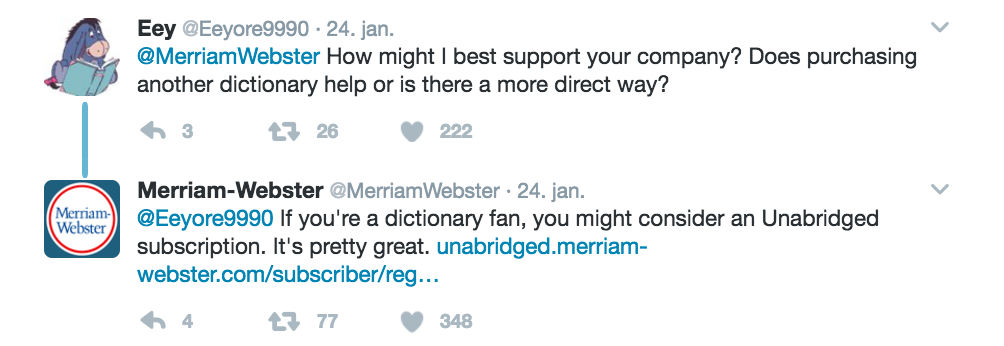
Merriam-Webster routinely seizes the opportunity to create content based on the most popular searches and word lookups of the moment. This ensures freshness for a 186-year-old company, entertaining its audience, staying relevant, and getting engagement.
Wendy’s Icarus Moment
Getting real on social media with one’s followers may not be for those without a clear vision of self-identity and brand story. Wendy’s took an original stance in customer interaction with its voice on social media, and delighted the internet by amiably roasting anyone who stepped to the brand. Wendy’s won fans and went viral with its clever burns on Thuggy-D, leading to more fun and genuine engagement with the brand and its newfound sass.
On the rise in popularity, its social media shine was instantly lost and the audience divided a mere two days later when it posted — and quickly deleted — a Pepe the Frog meme in response to a prompt:
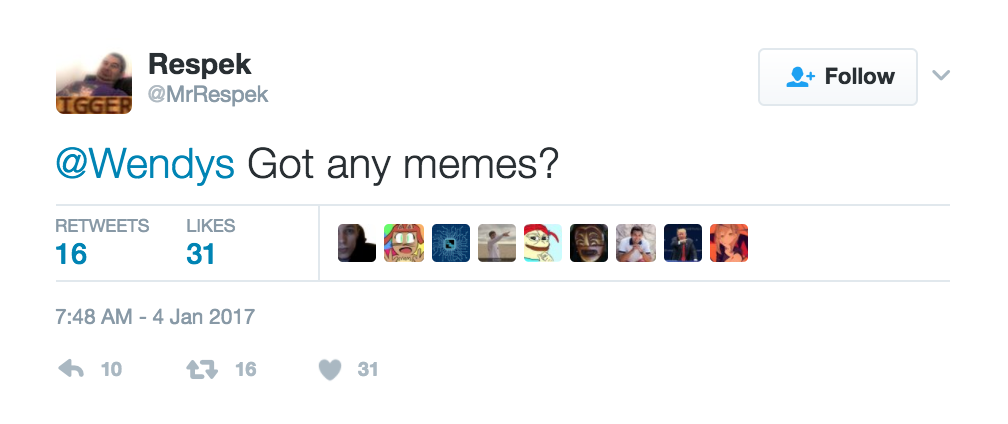
The internet was thrown into a crisis of cognitive dissonance by the offensive tweet of the hate symbol, and no one knew who Wendy’s was anymore.
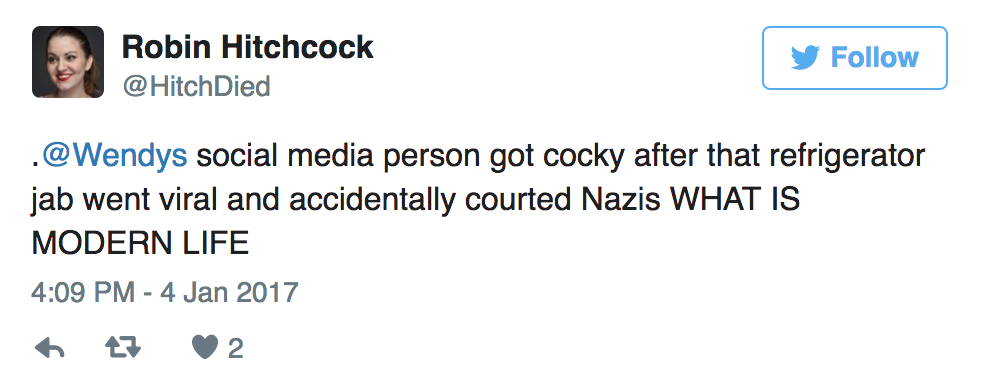
According to reports, Wendy’s issued apologies and a rep released the statement:
“A community manager was unaware of the recent connotations associated with the Pepe memes, and to avoid any miscommunication or perceived intent, we decided to remove it.”
This presents an awkward, unsatisfying finish to the story. It illustrates the brand’s loss of “personhood”, opening up the picture to include both the individual credited with the original tweets, and a more general bureaucratic haze of a large company’s social media team — out of touch with current events. The critical mass of its success was diminished.
After this fall from grace, recent tweets show @Wendys still having fun but taking a less edgy tack, relying more on retweeting its clever fans. This January, Wendy’s definitely illustrated the highs and lows possible in making a brand voice personal, and the risks posed when the team behind a brand’s identity is not on the same page.
Super Bowl Sides
As a country of immigrants, America itself is having a brand identity crisis when it comes to immigration, and this year’s Super Bowl ads provoked plenty of ire and applause around the subject, with depictions from Adolphus Busch of Budweiser, to the many faces of Airbnb customers. Despite its CEO supporting Trump and the wall, 84 Lumber’s poignant ad featuring a mother and daughter’s journey to the U.S. tried to promote the humanity of an immigrant’s journey, and was met with fierce anti-immigration backlash. Each ad was planned months in advance of the Super Bowl, yet faced an amplified reaction when mixed with current events.
Coca Cola courted familiar controversy by airing an ad from 2014, in which “America the Beautiful” is sung in a variety of languages. The commercial was met with an outcry of xenophobia when it first aired, so perhaps the brand already had an understanding of the segment of audience from which it could expect negative backlash The ad and its resurgence illustrate a company standing by a core element of inclusivity in its mission, affirming and maintaining consistency in its identity over the years.
Audi fared well with its ad expressing a commitment to the issue of gender equality and won approval from many. The emotionally resonant ad featured a dad’s nervous hopes for his daughter’s future, and ends with Audi’s commitment to “equal pay for equal work”. This succeeded in uniting an emotional issue its customers care about with the company policy that sets Audi apart. This is a great example of examining what your company does that is unique or important, and evolving a narrative to support it. However, be sure your company walks the walk it talks, because there will be scrutiny. As this twitter follower pointed out, Audi has no women on its board.
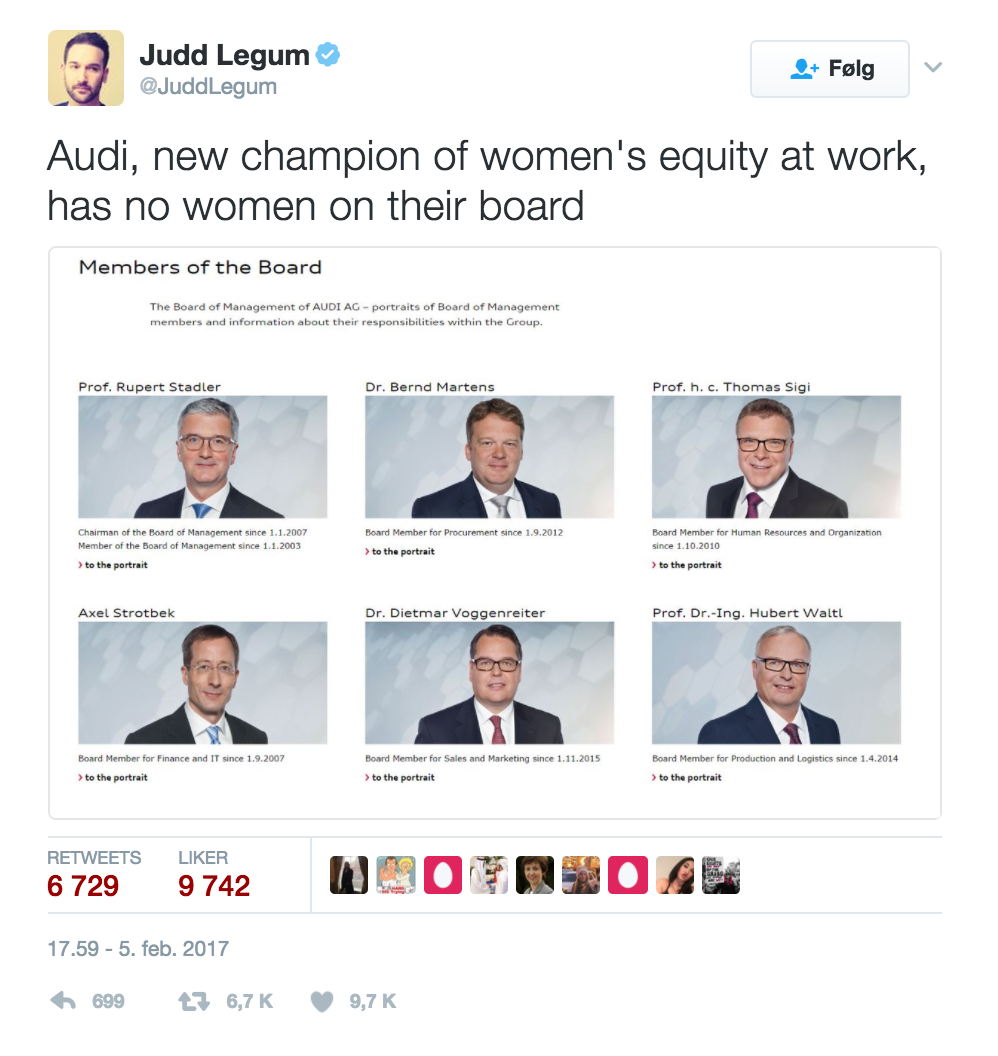
Engaging with current events can excite your audience and build a following, or offend and invite criticism. In today’s social climate, possibly both. The list goes on and on of companies that have stoked the ire of either side of the political fence. The lesson here for all is to begin with an understanding of the story your company should be telling, and consistently draw from that core. As ancient wisdom dictates, “know thyself”. We at Woden couldn’t agree more.
Mary McCool is a manager at Woden. Whatever your storytelling needs may be, let Woden help. Read our free StorytellingBlueprint, or send us an email at connect@wodenworks.com to discuss how we can help tell your story.


